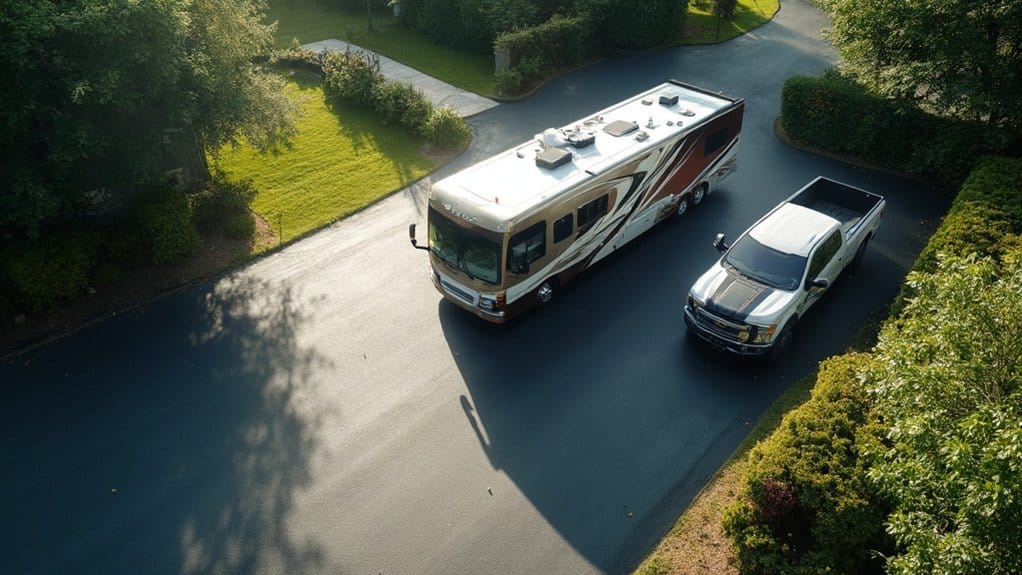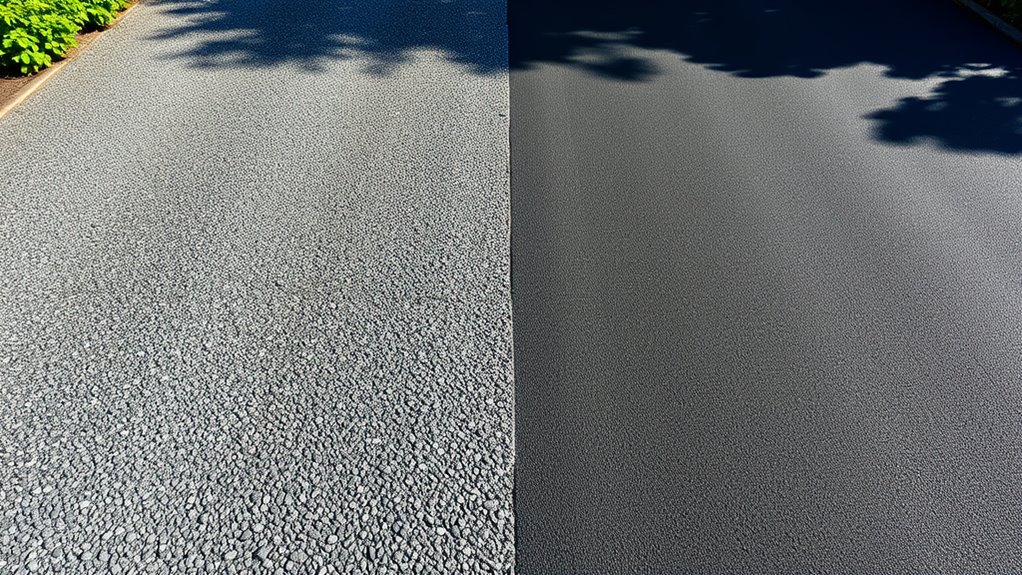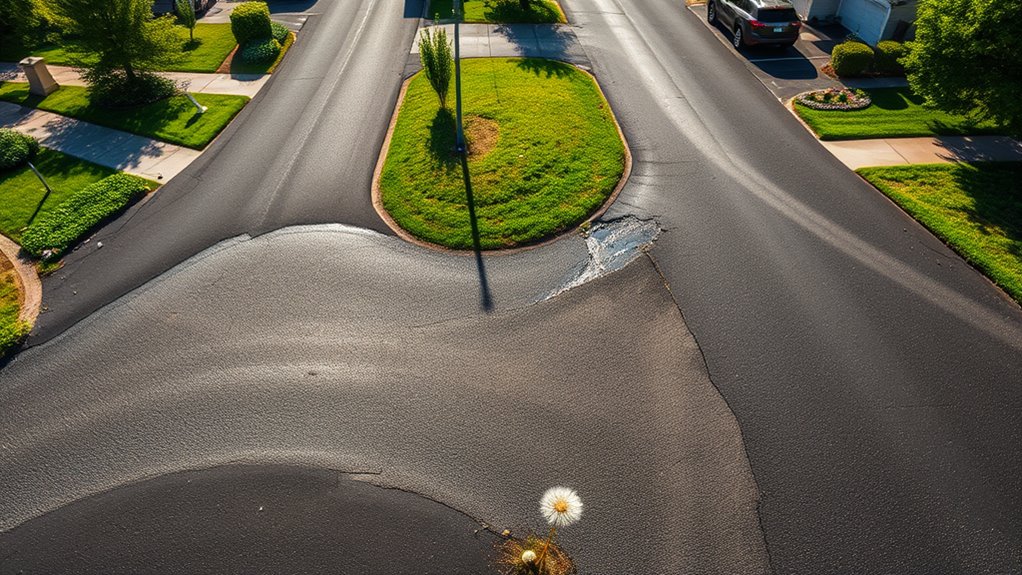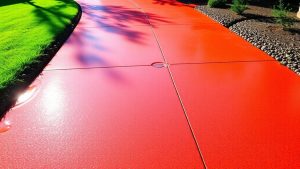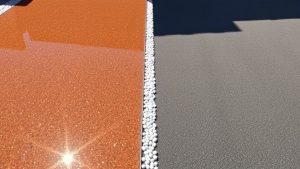Tarmac driveways can handle heavy vehicles like RVs and trucks, as long as they are built correctly. For these types of vehicles, a thickness of 75 to 100 mm is ideal, with 100 mm being best for regular heavy use. Using quality materials also boosts durability and can support loads of up to 20,000 pounds per axle. This makes tarmac a solid choice if you’re looking for a driveway that can endure heavy traffic.
Table of Contents
ToggleKey Takeaways
Tarmac driveways can support heavy vehicles like RVs and trucks if they are built to the right specifications. A thickness of 75 to 100 mm is generally recommended. To ensure stability for heavy loads, a well-compacted base layer of at least 150 mm is essential.
Using proper installation techniques, such as hot mix application, is crucial for durability when dealing with heavy vehicles. Regular maintenance, including crack repairs and sealcoating, will help prolong the lifespan of your tarmac driveway under heavy traffic.
Tarmac surfaces offer good traction and impact absorption, enhancing safety for both vehicles and pedestrians.
Understanding Tarmac Composition and Strength
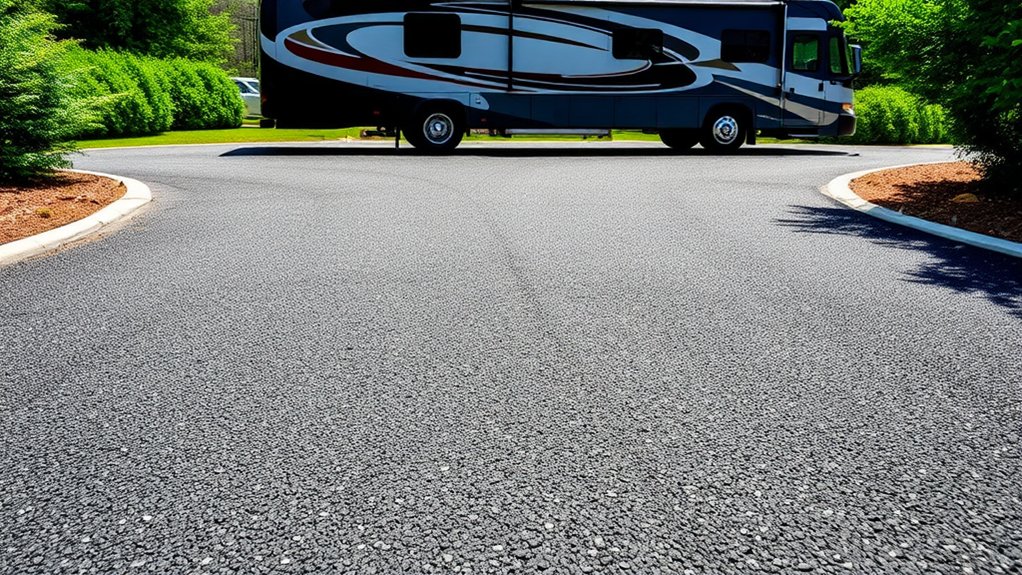
Tarmac driveways are made from a mix of aggregates and bitumen, creating a strong surface that can support heavy vehicles. In the past, tar was added to improve durability, but modern tarmac relies on advanced materials. The composition can vary by region and manufacturer, but it usually includes crushed stone and silica for added strength. Interestingly, tarmac’s composition can include larger aggregates, which affects its texture and durability. Proper installation techniques significantly influence overall longevity, ensuring the driveway can withstand heavy loads.
There are two methods of installation: hot mix and cold mix, with hot mix being the preferred option for new driveways. This method involves heating and compacting the mixture to form a solid surface that can withstand heavy traffic and harsh weather. With proper care, a tarmac driveway can last between 20 to 30 years, demonstrating its strength and longevity thanks to thoughtful engineering and material choice.
Load Capacity of Tarmac Driveways
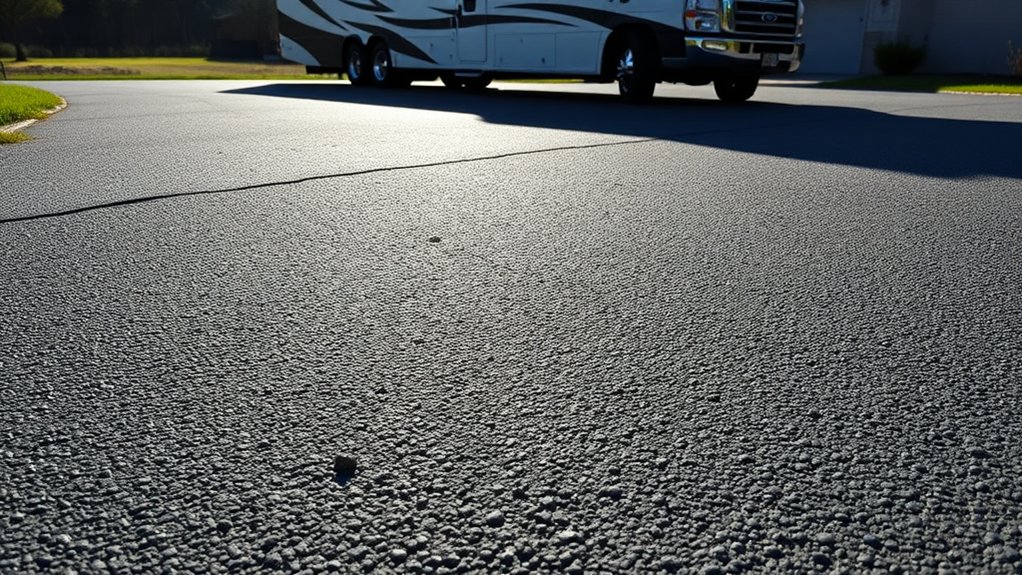
A well-built tarmac driveway can typically support up to 20,000 pounds per axle, making it suitable for many heavy vehicles. However, the load capacity can vary based on several factors, such as load distribution and how often you maintain it.
| Factor | Impact on Load Capacity |
|---|---|
| Thickness | Thicker layers can handle heavier loads |
| Quality of Materials | High-grade aggregates improve strength |
| Compaction Techniques | Proper compaction ensures structural integrity |
To extend your driveway’s lifespan, regular maintenance, like sealing, is crucial, especially with frequent heavy use. Be aware that extreme heat can temporarily soften the asphalt, impacting its load-bearing capacity. Additionally, reinforced concrete driveways offer greater stability, ensuring fewer repairs and better long-term reliability for heavy vehicle traffic. Properly installed tarmac driveways can last 20 to 30 years with minimal upkeep. By keeping these factors in mind, you can ensure your tarmac driveway remains effective for heavy vehicle use.
Ideal Thickness for Heavy Vehicle Use
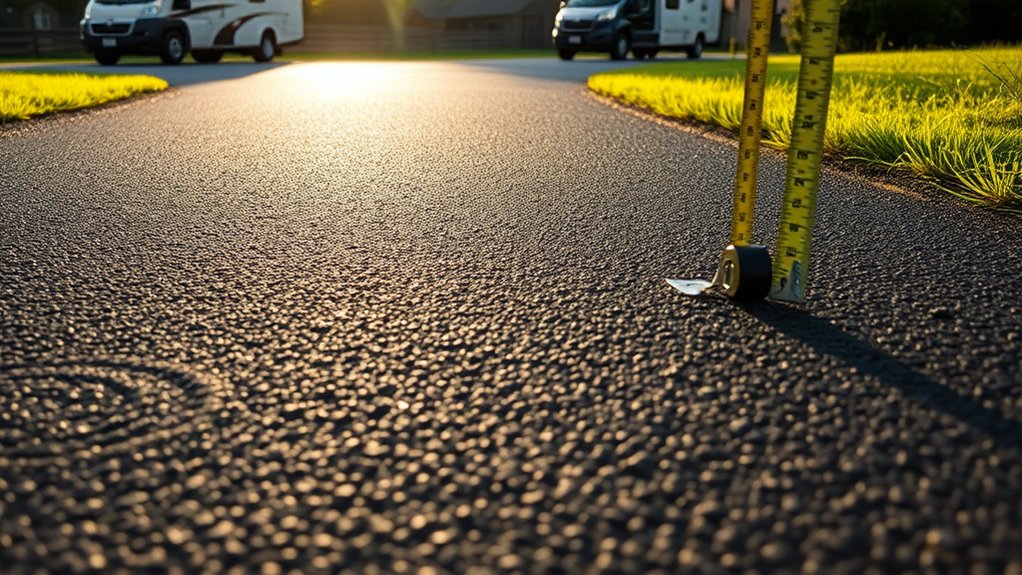
When planning tarmac driveways for heavy vehicle use, it’s crucial to follow recommended thickness standards for lasting durability.
For commercial applications, a thickness of 100 to 150 mm is essential. In contrast, residential driveways can generally manage with a thickness of 50 to 75 mm. This difference in thickness affects the driveway’s ability to support heavy loads and resist environmental wear over time. Thicker layers significantly improve driveway lifespan and ensure better performance under heavy traffic conditions. Additionally, tarmac’s strong load-bearing capacity is particularly beneficial for supporting the weight of heavy vehicles like RVs and trucks without the risk of cracking.
Recommended Thickness Standards
For heavy vehicle use, it’s crucial to get the thickness of your asphalt right to ensure durability and performance.
For tarmac driveways catering to RVs and trucks, a minimum thickness of 75 to 100 mm (3 to 4 inches) is recommended. This thickness meets the load-bearing requirements, allowing the surface to support the significant weight of these vehicles without risking structural damage.
In areas with frequent heavy traffic, consider increasing the thickness to at least 100 mm (4 inches).
To enhance stability and longevity, you should also have a well-compacted base layer of around 150 mm of type-1 material.
Proper installation is essential to avoid premature wear and maintain the integrity of your driveway under heavy loads.
Impact of Thickness on Durability
When selecting the right thickness for tarmac driveways designed for heavy vehicles, it’s crucial to understand how thickness impacts durability. The correct thickness helps distribute weight effectively and reduces the risk of cracking, which extends the lifespan of your driveway. Here’s a quick overview of thickness benefits and durability:
| Thickness (mm) | Load Capacity (tons) | Estimated Lifespan (years) |
|---|---|---|
| 100 | 5 | 10 |
| 150 | 10 | 20 |
| 200 | 15 | 25 |
| 250 | 20 | 30 |
| 300 | 25 | 35 |
Choosing the right thickness can lower maintenance costs and improve resistance to weather, protecting your investment from premature wear and tear. For instance, if you regularly park a heavy van, opting for a thickness of 200mm or more would be wise to ensure durability.
The Importance of Soil Compaction
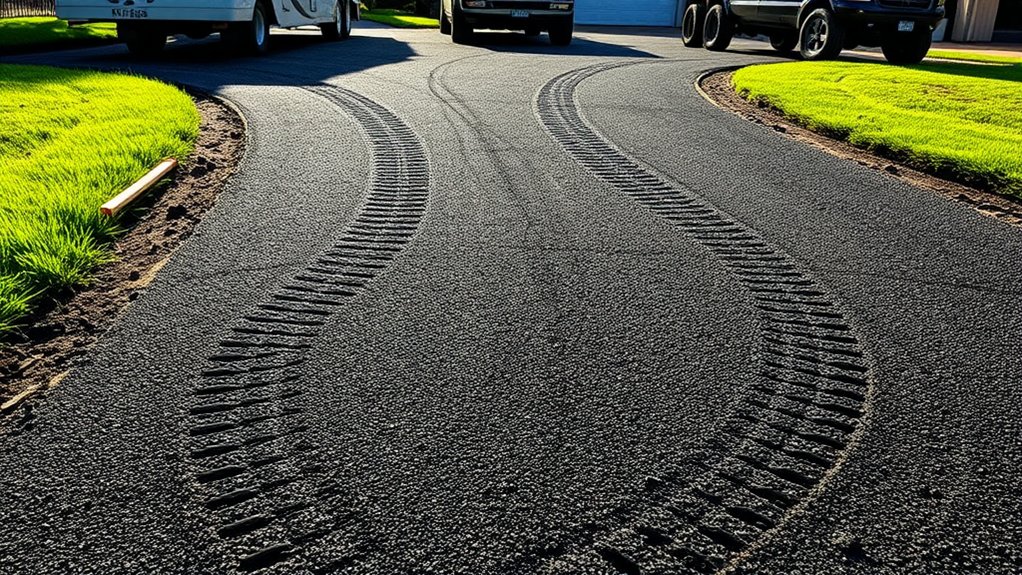
Soil compaction is vital for ensuring your driveway can support heavy vehicles. By increasing soil density, compaction techniques remove air pockets, creating a solid foundation that can handle significant weight.
This added strength helps prevent settling, which can cause problems like cracks and potholes. Well-compacted soil also reduces water seepage and erosion, prolonging the life of your driveway.
Before laying top surfaces such as tarmac, achieving proper compaction through layered applications and testing is essential. Without adequate compaction, your driveway may become uneven, leading to costly repairs.
Therefore, prioritising effective compaction techniques is crucial for a stable base that reliably supports heavy vehicles.
Surface Quality and Traction Benefits
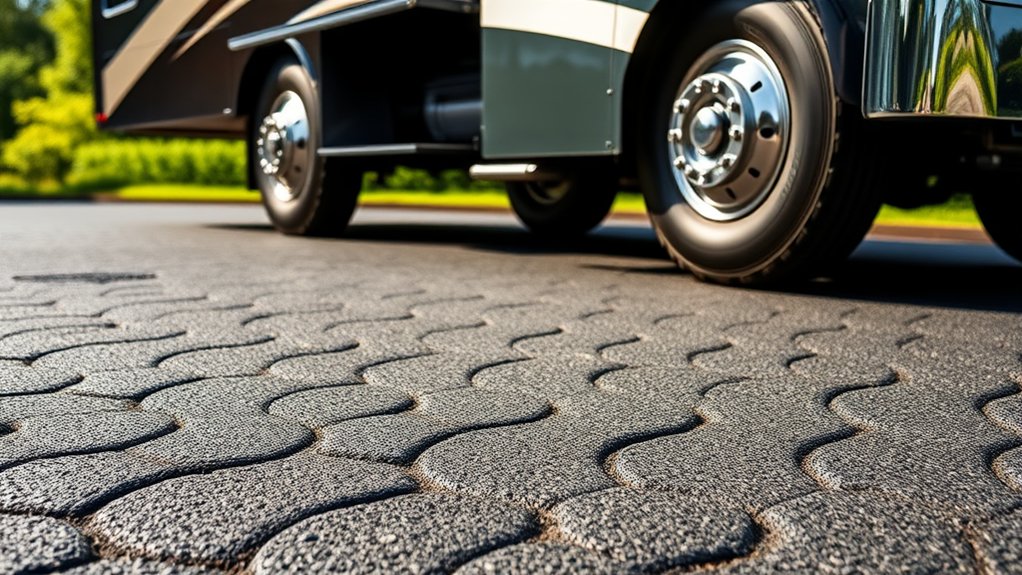
A well-constructed tarmac surface improves the manoeuvrability of heavy vehicles, making it easier to navigate tight spaces.
Its textured finish enhances traction, significantly reducing the risk of slipping, even in wet weather.
This combination ensures a safer driving experience and optimises performance when carrying heavy loads.
Enhanced Maneuverability Safety
When it comes to the safety and manoeuvrability of tarmac driveways for heavy vehicles, the quality of the surface is crucial.
Tarmac’s smooth finish provides excellent manoeuvrability, reducing resistance and improving vehicle control. This resilient surface minimises slip hazards, particularly in wet weather, allowing for better traction. Its flexibility helps absorb minor impacts, which protects both the driveway and your vehicle from damage.
Regular maintenance, such as sealing, is important to keep the surface smooth and ensure long-lasting durability. Furthermore, a well-installed tarmac driveway prevents uneven patches, enhancing your overall driving experience.
With these advantages, tarmac driveways are a solid choice for accommodating heavy vehicles like caravans and lorries.
Improved Traction Performance
When it comes to ensuring optimal traction for heavy vehicles, the quality of the tarmac surface is crucial. Its textured finish significantly boosts traction, especially in wet weather. The blend of aggregate and bitumen gives tarmac the strength needed to support heavy loads without deformation.
Moreover, its resistance to extreme weather ensures reliable surface safety, maintaining grip during rain, snow, or sleet. Properly laid tarmac enhances stability, which can lead to reduced tyre wear and lower fuel consumption for larger vehicles like lorries and motorhomes.
The use of high-quality aggregates and specialised binders ensures durability, while its minimal maintenance requirements help preserve traction over time. In summary, tarmac driveways are an excellent choice for safely accommodating heavy vehicles.
Safety Considerations for Heavy Vehicles
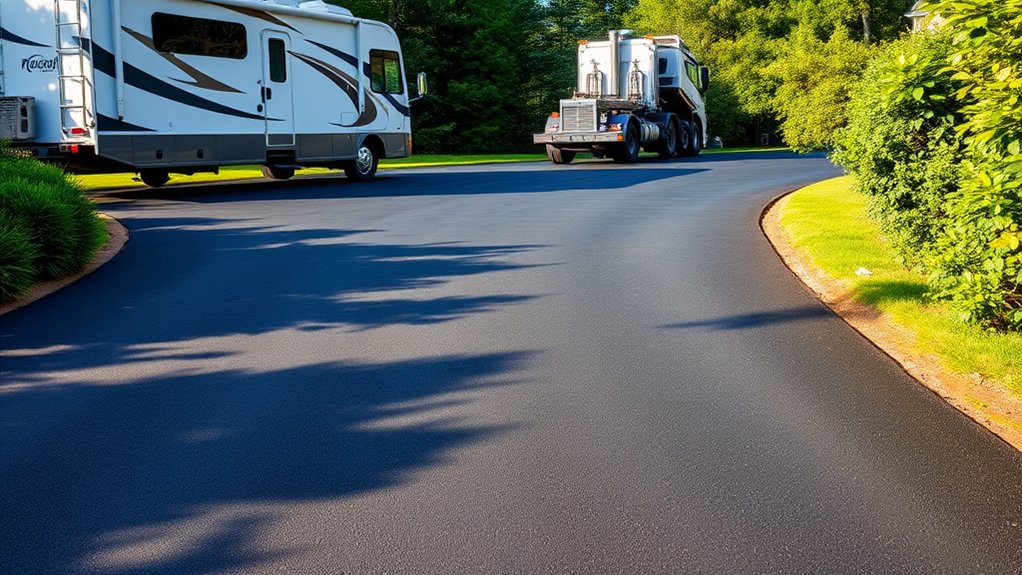
Ensuring safety for heavy vehicles on tarmac driveways relies on key factors such as surface smoothness and impact absorption. Following safety regulations and understanding vehicle specifications are crucial for optimal performance.
- A flat, slip-resistant surface reduces risks for both vehicles and pedestrians.
- Good impact absorption helps lessen stress on the tarmac, which increases its lifespan.
- A dark surface enhances visibility in low light, making navigation safer.
- Resistance to potholes ensures an even surface, reducing hazards from uneven ground.
These features work together to create a safer environment for heavy vehicles like RVs and lorries, allowing for reliable access while preserving the structural integrity of the driveway over time.
Quick Installation and Minimal Disruption
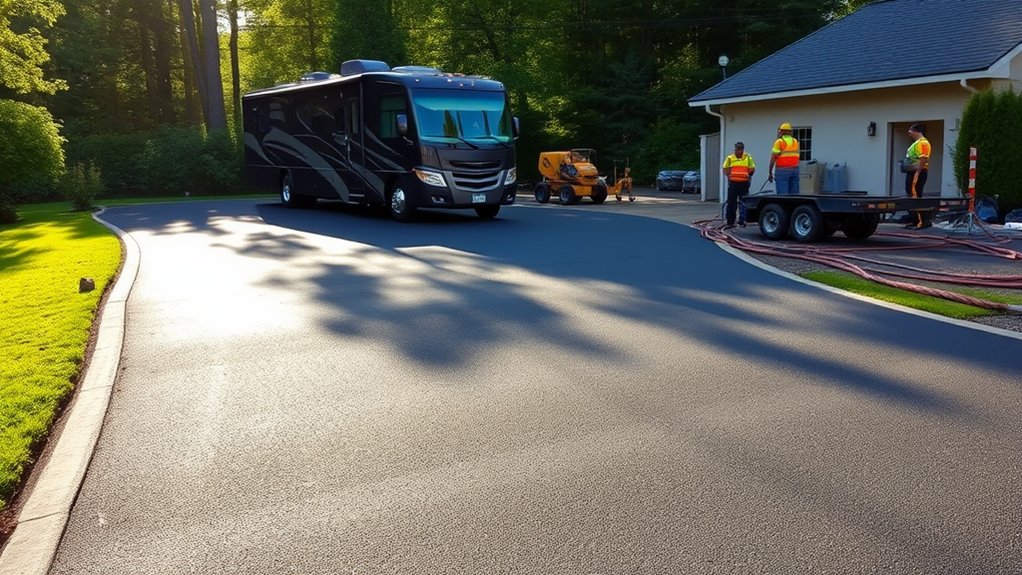
With heavy vehicle traffic in mind, the quick installation of tarmac driveways is crucial for minimising disruption to both homes and businesses. Tarmac can be laid and compacted efficiently, making it ready for light traffic in just 24 to 48 hours with the right site preparation.
| Benefits | Details |
|---|---|
| Quick Usability | Ready to use in 24-48 hours |
| Minimal Disruption | Less downtime for daily operations |
| Enhanced Stability | Proper base preparation avoids problems |
This means you can get back to your routine sooner, whether you’re managing a residential property or a commercial site.
Long-Term Maintenance and Cost Efficiency
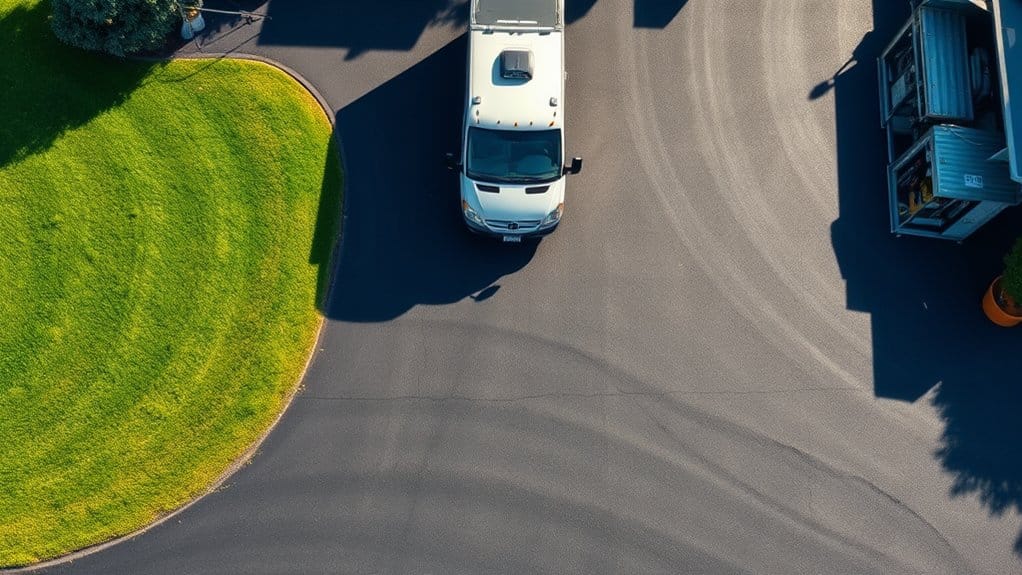
To keep tarmac driveways in top shape for heavy vehicles, regular maintenance is crucial. This not only preserves the driveway’s appearance but also ensures cost efficiency over time.
Here are some essential maintenance tasks:
- Regular cleaning to avoid dirt accumulation.
- Sealcoating every 3 to 5 years to protect against the elements.
- Routine inspections to identify cracks early on.
- Prompt crack repairs to prevent further damage.
Implementing seasonal maintenance can significantly prolong the life of your driveway and lower repair costs.
Tarmac driveways are typically cost-effective to install and maintain, making them a wise investment. By managing vehicle loads and committing to regular upkeep, you can achieve long-term savings while keeping your driveway in excellent condition.
Weather Resistance and Performance
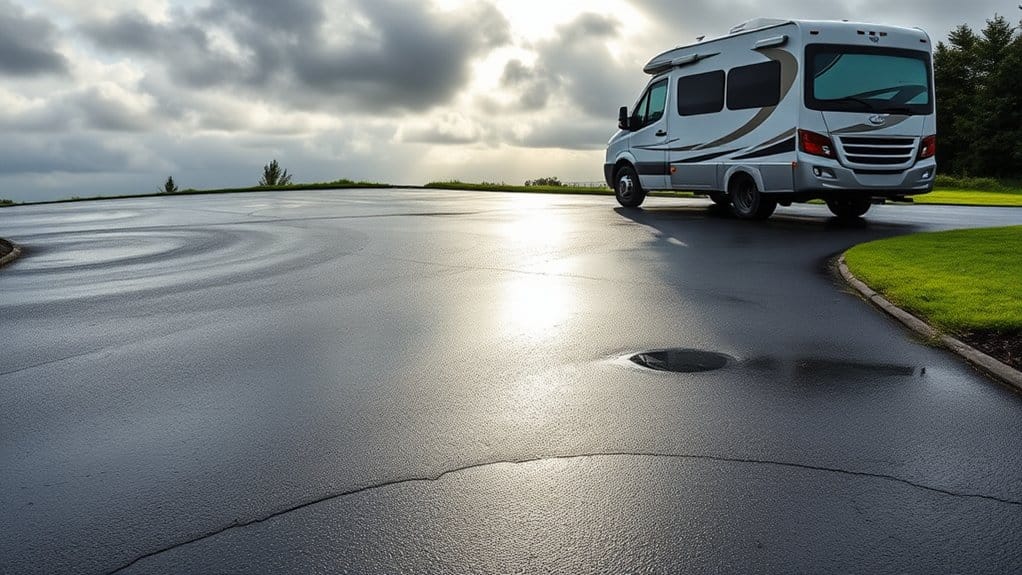
When choosing tarmac driveways for heavy vehicles, it’s crucial to consider their ability to withstand temperature changes.
Tarmac effectively drains water, preventing pooling that can cause erosion and damage.
Moreover, its resistance to frost ensures your driveway stays stable and functional, even during harsh winter months.
Temperature Fluctuation Resilience
Temperature fluctuations can significantly affect the performance of tarmac driveways, making it crucial to understand their resilience for long-lasting durability, particularly with heavy vehicle use.
Here’s what you need to know:
- Tarmac should ideally be laid between 10°C and 32°C.
- Its flexibility helps prevent cracking when temperatures rise.
- Be aware that tarmac begins to soften at 50°C, which can lead to rutting.
- Ensuring proper installation is key to improving resilience against extreme heat and cold.
Water Drainage Efficiency
Effective water drainage is crucial for preserving tarmac driveways, particularly when subjected to heavy vehicles. Without adequate drainage solutions, standing water can erode the surface and undermine the driveway’s stability. Installing channel drains or French drains can effectively manage water runoff and ensure compliance with UK regulations. A well-designed slope helps direct water away, preventing accumulation and potential damage.
| Drainage Solution | Benefits |
|---|---|
| Channel Drains | Can handle up to 12.5 tonnes, effectively redirects water |
| French Drains | Guides water into gravel-filled trenches |
| Permeable Pavers | Filters rainwater, reducing standing water |
| Storm Drain Connection | Prevents flooding, protects foundations |
| Regular Maintenance | Optimises performance, ensures compliance |
Frost Damage Resistance
Frost damage resistance in tarmac driveways relies on several key factors that improve their durability in harsh winter conditions.
To protect your driveway from frost damage, consider the following effective methods and maintenance tips:
- Smooth surface: This reduces snow build-up and makes clearing it easier.
- De-icing compatibility: Use agents like rock salt to quickly melt ice and snow.
- Freeze-thaw resilience: Driveways should be able to withstand repeated freezing and thawing cycles, although be mindful of water ingress.
- Traffic stress absorption: A good tarmac surface can handle the weight of heavy vehicles without cracking.
Environmental Considerations for Tarmac
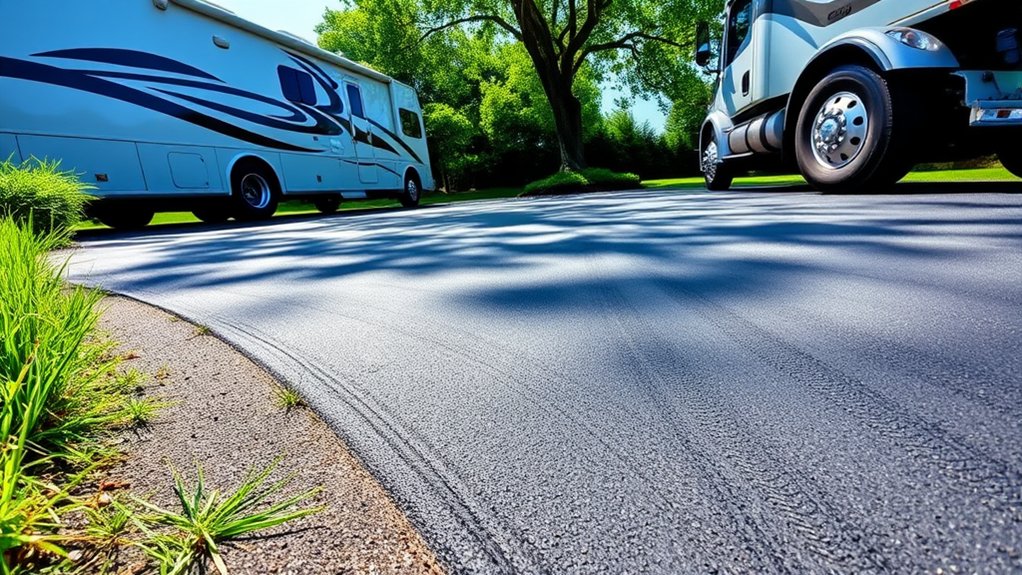
While tarmac driveways are popular for their durability and low maintenance, their environmental impact is significant. Producing tarmac relies heavily on crude oil, which contributes to resource depletion and greenhouse gas emissions due to the high temperatures involved in processing.
Furthermore, tarmac’s impermeable surface increases water runoff, potentially polluting local waterways and disrupting local ecosystems during raw material extraction.
However, there are sustainable alternatives emerging in tarmac production. Options such as recycled materials, warm mix asphalt, and biogenic asphalts can significantly lower the carbon footprint and reduce resource consumption.
Comparing Tarmac With Other Driveway Materials

When choosing a driveway, tarmac is a strong contender due to its durability and cost-effectiveness, particularly for heavier vehicles.
Here’s how it stacks up against other materials:
- Tarmac: Made from a mix of tar and aggregate, it’s built to support heavy loads.
- Asphalt: Offers greater flexibility and durability, but usually comes at a higher cost.
- Resin-bound driveways: Attractive but not ideal for very heavy vehicles.
- Concrete: Durable and long-lasting, yet can crack under significant weight.
While tarmac may not have the visual appeal of resin or paving stones, its benefits for heavy vehicles make it a sensible option.
It’s important to evaluate alternatives, as some may not hold up against the demands of larger vehicles like RVs and trucks as well as tarmac does.
Frequently Asked Questions
How Long Does a Tarmac Driveway Typically Last Under Heavy Vehicle Use?
A tarmac driveway generally lasts between 10 to 15 years, especially when subjected to heavy vehicles. The lifespan depends on factors like the quality of the installation, the thickness of the tarmac, and regular maintenance. For instance, parking a heavy van or lorry frequently can accelerate wear, so it’s important to address any cracks or damage promptly to extend its life.
Can Tarmac Driveways Be Repaired Easily if Damaged?
Repairing tarmac driveways is straightforward with the right techniques. Address any cracks quickly to prevent further damage, seal the surface regularly, and ensure a solid foundation for long-lasting durability. Think of it like maintaining a bicycle; regular checks and fixes keep it in good shape for years.
What Is the Best Time of Year to Install a Tarmac Driveway?
For the best time to install a tarmac driveway, target the warmer, drier months. Factors like temperature and moisture can significantly affect the curing process. Proper ground preparation and steering clear of extreme weather will ensure a tarmac driveway that can handle heavy vehicle use effectively. For instance, late spring to early autumn is typically ideal in the UK.
Are There Color Options Available for Tarmac Driveways?
Tarmac driveways typically come in a limited range of colours. However, if you’re looking to add some flair, you can consider decorative aggregates. These not only enhance the visual appeal of your driveway but also maintain its durability and functionality. For instance, mixing in coloured stones can create a unique look that sets your driveway apart.
How Does Tarmac Handle Extreme Weather Conditions Over Time?
Tarmac is designed to resist extreme weather conditions, effectively coping with temperature changes. It remains stable in both hot and cold weather, preventing issues like cracking. Its flexibility helps it adapt to various conditions, ensuring durability over time. For instance, unlike standard surfaces that may buckle during a heatwave or crack in frost, Tarmac maintains its integrity, making it a reliable choice for driveways and roads alike.
Conclusion
In summary, tarmac driveways can be suitable for heavy vehicles like RVs and trucks, as long as they are designed and maintained properly. Think of it as a robust surface that needs the right thickness and proper soil preparation to support significant weight. With regular maintenance, a tarmac driveway can withstand wear and tear, providing a reliable route for your heavy vehicles while combining durability and practicality.
How can a tarmac driveway enhance your home's appeal? Discover the key aspects of cost, installation, and maintenance in our Read more
Beneath the surface of tarmac and asphalt driveways lies a world of differences; discover which option suits your needs best.
Uncover the hidden environmental costs of tarmac driveways and explore whether they truly align with sustainable living—what alternatives could be Read more

